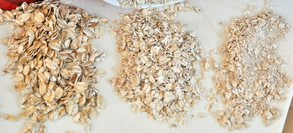 So, you’re in the grocery store and before you, you see various types of oats. Rolled, quick, instant, old fashion….what’s a girl to do? I just wanted a bowl of hot oatmeal for breakfast! I hope in the next few minutes I will be able to give you confidence of what OAT is best for your recipe.
So, you’re in the grocery store and before you, you see various types of oats. Rolled, quick, instant, old fashion….what’s a girl to do? I just wanted a bowl of hot oatmeal for breakfast! I hope in the next few minutes I will be able to give you confidence of what OAT is best for your recipe.
Oat Groat
All oats start off as an oat groat. A groat is simply the whole unbroken grain of oat. Before being made into any other variety of oat, groats are usually roasted at a very low temperature. This not only gives the oats their nice toasty flavor, but the heat inactivates the enzyme that causes oats to go rancid.
Steel-cut Oats
Steel-cut oats are whole grain groats, the inner portion of the oat kernel, which have been cut into two or three pieces rather than flattened. These oats take longest to digest and keep us feeling fuller longer. They are packed full of fiber and they help eliminate fat and cholesterol from the body.
Rolled Oats
The outer tough shell of the hull is first removed and the interior of the grain is used. The grain is then steam treated in order to further soften the grain. Once the oat grains are steamed properly, the grain is run through an oat roller, creating the flat oats. This is how they get their name… rolled oats. This variety can be found as either thick or thin.
Old Fashioned Oats
Don’t let the name confuse you, these oats are the same as rolled oats.
Quick Oats
These oats are very similar to rolled oats. The only exception is that they are rolled thinner than rolled oats. This allows them to absorb water quicker, giving them a shorter cooking time. Quick oats lose some of their texture during the rolling phase.
Instant Oats
Instant oats are rolled thinner than quick oats and often break into course powder. They cook the quickest and become very soft during cooking. The easiest way to describe instant oats is “mush” when cooked.
Oats are an excellent source of fiber in our diets, so whatever variety you choose you are making a healthy choice. Just be sure to read labels and AVOID the packages that include any sugar. One final note, Harold McGee in “On Food and Cooking” says that all processed oats have the same nutritional value. Uh, who knew?
What is your favorite type of oat? Share with us your favorite recipe in the comment section below! Do you know anyone that has been wondering what the difference is between steel-cut oats and instant oats? Share this article with them by using the Facebook and Twitter links and be sure to eat your oats!


